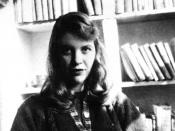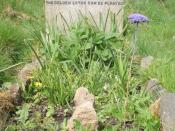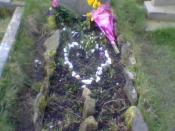The interpretations of texts evolve as times change due to different ideas within society. These differing ideas bring with them more ways to look at a text and to gather new ideas from it. Different societies throughout the world can also draw different meanings from a text based upon the different experiences that a culture has been exposed to. Sylvia PlathÃÂs poems have not escaped this change in interpretations. ÃÂYouÃÂreÃÂ and ÃÂLast WordsÃÂ are two poems that have taken on different meanings as society has changed and different critical readings can be applied to these texts.
The following readings of PlathÃÂs poetry are possible because times have changed since they were written and new ways to analysis poetry and new critical readings have been developed. The change to social morals and values have also allowed the reader to apply different morals and values to the poems. Other reasons that different readings may be applied to PlathÃÂs poetry are that it is now reaching more people with different backgrounds and heritage and different social experiences.
Multiple readings of PlathÃÂs poetry are also possible for these reasons. She was writing during a time of a major change in social attitudes which allowed more personal opinions to shine through and different ideas to develop within the poem. The below readings can greatly affect reader responses as they bring new ideas to the reader which may change their opinion of what they have been exposed to.
ÃÂYouÃÂreÃÂ draws upon both biographical and psychoanalytical readings in the present day context to understand and draw out different ideas and meanings from the text. ÃÂYouÃÂreÃÂ shows the continuous and universal ideas about the growth of a child inside its mother and the thought process of trying to define what and who this child is. This theme is both universal as well it does not matter what part of the world or era that the reader is from they can identify with PlathÃÂs feelings of motherhood and understand what she is saying.
The biographical reading of ÃÂYouÃÂreÃÂ is highlighted through the use of similes to describe the gestation period of PlathÃÂs first child ÃÂmute as a turnip from the Fourth of July to all Fools DayÃÂ. This simile also makes reference to PlathÃÂs American heritage by naming the dates of conception and birth by well known and celebrated American holidays. This reference to her heritage, in a positive way, shows her happiness of being from America. The excitement and anticipation of Plath is also shown in the use of these popular and highly celebrated holidays. Plath is celebrating the arrival of her baby in the same regards that Americans choose to celebrate their favourite holidays. The continued use of similes and metaphors throughout the poem also alludes to the experiences of Plath during pregnancy ÃÂa creel of eels, all ripples. Jumpy as a Mexican bean.ÃÂ. These insights into PlathÃÂs life further draw the reader into PlathÃÂs world and show the love and expectation that Plath felt towards her unborn baby. The biographical reading also heightens the responders opinion of Plath as it shows her more nurturing side of her. This poem also shows the reader a more positive look at PlathÃÂs heritage, and her life.
ÃÂYouÃÂreÃÂ can also be read from a psychoanalytical perspective. Within the text Plath attempts to define who and what her baby is and to create itÃÂs identity within her mind. The metaphor ÃÂvague as fog and looked for like mailÃÂ shows PlathÃÂs struggle and anticipation of her unborn babyÃÂs identity. Plath tries to create the identity of her unborn baby within her own mind and in the end uses the simile ÃÂright like a well done sumÃÂ to define how she finally feels and defines her unborn baby. She also talks about the psychology of when the baby will be born and brings up the long debated ideas of nature verus nurture ÃÂa clean slate, with your own face onÃÂ. This shows the inner psyche of PlathÃÂs own thoughts of this issue. These last two lines show PlathÃÂs final understand of what her unborn baby will bring into this world. This reading allows the reader to delve even deeper into PlathÃÂs world by allowing the reader into PlathÃÂs ideas and morals instead of just her heritage. The psychoanalytical reading not only shows responders PlathÃÂs morals but her more motherly tendencies and a mother figuring out what her baby means to her and what it will be like. This appeals to responders and they are draw into the mind of Plath and the universal ideas of trying to grasp the unknown.
ÃÂLast WordsÃÂ draws upon psychoanalytical and historical readings to highlight issues and themes within PlathÃÂs poem that are still relevant in todayÃÂs world. These readings create a greater understanding of ÃÂlast wordsÃÂ and help the reader identify with PlathÃÂs universal evaluation of self and her questioning of her legacy. These ideas are universal and surpass both time and location as it is a journey of self discovery that everyone must take before the end of their life.
The poem ÃÂlast wordsÃÂ can be read using a psychoanalytical reading. Plath is looking at herself and wondering what her memory will be that she leaves behind. By using the mirror as a metaphor for looking at herself and its clouding over ÃÂmy mirror is clouding over a few more breaths and it will reflect nothing at allÃÂ shows her sense of urgency in her self evaluation as her time is running out and will soon be gone. Plath also separates herself from the rest of society in her self evaluation by using a juxtaposition of ÃÂthey and IÃÂ to define who she is talking about. This separates her from the rest of society and creates the individual self evaluation aspect to the poem. Responders are drawn once again in PlathÃÂs mind and emphasise with her plight of internal self evaluation. This plight is universal and transcends both time and place. Responders can put themselves in PlathÃÂs shoes using this reading and have a greater understand of PlathÃÂs inner thoughts.
The historical reading of ÃÂlast wordsÃÂ shows Plath contemplating her death and the life after she is gone by showing changing the context of time. By constantly referring to the historical symbols such as a ÃÂsarcophagusÃÂ and ÃÂIshtarÃÂ Plath creates a motif of both ancient Egypt and ancient mythology. This takes away the element of time and modern day context and takes the responder with Plath back to ancient times. The historical aspect of the poem also talks about being discovered years later, this ensures that the reader is further removed from the modern day context. Plath places herself and the reader in the same time as ancient Egyptians thus making the poem timeless. As is not written in the modern day context the poem takes the responder back to a past world thus ensuring readers no matter where they are from or what year it is will be able to read and understand what Plath is projecting to the reader. The historical reading also allows the reader deeper understand of what Plath is telling the reader about the timeless not only of herself but of all people.
Sylvia PlathÃÂs poetry transcends time and location as they contain universal themes and issues that appeal to a large proportion of society. The different ways that her poems can be read has changed over time with different readings but the internal themes and messages that Plath projects to the reader have remained the same.
bibliographyclass work YR 11





